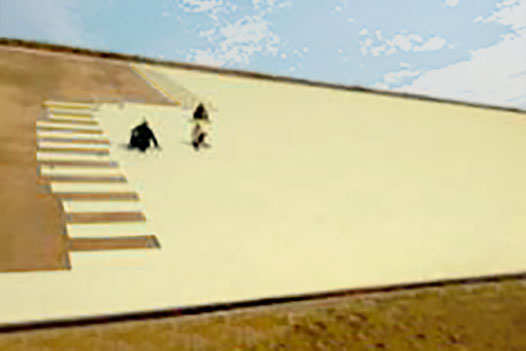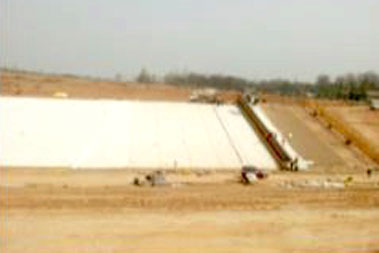Long-term commitment to the R & D and manufacturing of extruded board insulation materials, a new service platform
Production workshop feeding volume per hour 2 tons, daily output 1000 cubic meters

The core role of extruded sheet (XPS) laying in water conservancy dams: A comprehensive analysis from engineering principles to protection mechanisms
1. Temperature control and crack prevention: solving the problem of temperature stress in mass concrete
Hydration heat control during construction period
When pouring mass concrete dams (such as gravity dams and arch dams), the heat of cement hydration causes the internal temperature to reach 60-80℃, and temperature cracks will occur when the temperature difference between the surface and the interior exceeds 25℃. Extruded sheets are laid on the surface of the dam body to form a thermal resistance layer, which controls the internal and external temperature differences within 5-10℃, significantly reducing the risk of cracks.
Case: During the construction of the diversion bottom outlet of the Three Gorges Dam, a 50-mm-thick extruded plate was laid on the surface of the dam body and combined with cooling water pipes to control the temperature difference at 8 ° C, and the crack incidence rate was reduced by 70%.
Free-swelling protection during operation
When dams in severe cold areas (such as Northeast and Northwest) are frozen in winter, concrete pore water freezes and expands to produce about 9% volume deformation. Repeated freezing and thawing may easily lead to surface erosion. The closed pore structure of the extruded board (closed pore ratio ≥99%) blocks water penetration, while the insulation layer maintains the surface temperature of the dam body above-5 ℃, reducing the frost heaving damage by more than 80%.

2. Anti-seepage and anti-seepage: a key link in building a composite waterproofing system
Blocking the infiltration path
The water absorption rate of the extruded board itself is ≤0.5%(volume water absorption rate). When laid on the contact surface of the dam foundation or dam abutment, it can isolate the direct contact between groundwater and the dam concrete. For example, after extruded boards are laid on the slope of an earth-rock dam, they are combined with geomembrane to form a "thermal insulation + anti-seepage" double-layer structure to reduce the permeability coefficient.
Water-reducing zone protection
The concrete in the reservoir water level frequently fluctuates (water-level fluctuation zone) is subject to long-term alternating erosion of dry and wet. The water resistance of the extruded board can resist repeated penetration of water and avoid concrete carbonization and corrosion of steel bars. For example, after 60mm extruded slabs were laid in the water-level-fluctuating zone of the Danjiangkou Reservoir dam, the concrete carbonization depth was reduced from 50mm to 15 mm.
3. Structural support and protection: invisible skeleton to improve the durability of the dam
withstand dynamic loads
The extruded plates (compressive strength ≥300kPa) laid on the floor of the spillway can resist the erosion and cavitation damage of high-speed water flow (flow velocity ≥30m/s). For example, the floor of the spillway tunnel of the Xiaolangdi Water Conservancy Project is made of 80mm thick X500 extruded slab and matched with steel fiber concrete to extend the anti-erosion and wear life of the floor to more than 50 years.
Frozen soil stability control
When the dam foundation is located in a seasonal frozen soil, the extruded board insulation layer can reduce the upper limit of the frozen soil layer by 1-2m to avoid fluctuations in the bearing capacity of the dam foundation soil due to freeze-thaw cycles (for example, after laying a 100mm extruded board on the dam foundation of a reservoir on the Qinghai-Tibet Plateau, the foundation settlement dropped from 120mm to 30mm).
4. Energy conservation and operation and maintenance: core elements of full life cycle cost optimization
Reduce temperature control energy consumption
Thermal insulation of the dam body during the winter water storage period can reduce artificial heating measures. For example, after a 30-meter-high concrete dam uses extruded board insulation, the energy consumption for temperature control in winter is reduced by 60%, and the annual electricity bill for a single dam section is saved by about 200,000 yuan.
reduce maintenance costs
The long life and aging resistance of extruded panels reduce the frequency of dam renovations. For example, the insulation layer of the Hoover Dam in the United States uses extruded panels, which still maintains good performance after 70 years of operation, and the maintenance cost is 40% lower than that of traditional insulation materials.
Summary: The essential value of extruded boards in dam engineering
Extruded panels transform the core risks faced by dams such as temperature stress, seepage damage, and frost heaving deformation into controllable variables through heat-water-force multi-field coupled control. Their role is not only a single insulation or waterproofing, but also a key technical means for building "actively protected dam body". From the Three Gorges and Xiaolangdi to the practice of global high dam projects, extruded panels have become a standard component in the durability design of modern water conservancy projects.
1. Temperature control and crack prevention: solving the problem of temperature stress in mass concrete
Hydration heat control during construction period
When pouring mass concrete dams (such as gravity dams and arch dams), the heat of cement hydration causes the internal temperature to reach 60-80℃, and temperature cracks will occur when the temperature difference between the surface and the interior exceeds 25℃. Extruded sheets are laid on the surface of the dam body to form a thermal resistance layer, which controls the internal and external temperature differences within 5-10℃, significantly reducing the risk of cracks.
Case: During the construction of the diversion bottom outlet of the Three Gorges Dam, a 50-mm-thick extruded plate was laid on the surface of the dam body and combined with cooling water pipes to control the temperature difference at 8 ° C, and the crack incidence rate was reduced by 70%.
Free-swelling protection during operation
When dams in severe cold areas (such as Northeast and Northwest) are frozen in winter, concrete pore water freezes and expands to produce about 9% volume deformation. Repeated freezing and thawing may easily lead to surface erosion. The closed pore structure of the extruded board (closed pore ratio ≥99%) blocks water penetration, while the insulation layer maintains the surface temperature of the dam body above-5 ℃, reducing the frost heaving damage by more than 80%.

2. Anti-seepage and anti-seepage: a key link in building a composite waterproofing system
Blocking the infiltration path
The water absorption rate of the extruded board itself is ≤0.5%(volume water absorption rate). When laid on the contact surface of the dam foundation or dam abutment, it can isolate the direct contact between groundwater and the dam concrete. For example, after extruded boards are laid on the slope of an earth-rock dam, they are combined with geomembrane to form a "thermal insulation + anti-seepage" double-layer structure to reduce the permeability coefficient.
Water-reducing zone protection
The concrete in the reservoir water level frequently fluctuates (water-level fluctuation zone) is subject to long-term alternating erosion of dry and wet. The water resistance of the extruded board can resist repeated penetration of water and avoid concrete carbonization and corrosion of steel bars. For example, after 60mm extruded slabs were laid in the water-level-fluctuating zone of the Danjiangkou Reservoir dam, the concrete carbonization depth was reduced from 50mm to 15 mm.
3. Structural support and protection: invisible skeleton to improve the durability of the dam
withstand dynamic loads
The extruded plates (compressive strength ≥300kPa) laid on the floor of the spillway can resist the erosion and cavitation damage of high-speed water flow (flow velocity ≥30m/s). For example, the floor of the spillway tunnel of the Xiaolangdi Water Conservancy Project is made of 80mm thick X500 extruded slab and matched with steel fiber concrete to extend the anti-erosion and wear life of the floor to more than 50 years.
Frozen soil stability control
When the dam foundation is located in a seasonal frozen soil, the extruded board insulation layer can reduce the upper limit of the frozen soil layer by 1-2m to avoid fluctuations in the bearing capacity of the dam foundation soil due to freeze-thaw cycles (for example, after laying a 100mm extruded board on the dam foundation of a reservoir on the Qinghai-Tibet Plateau, the foundation settlement dropped from 120mm to 30mm).
4. Energy conservation and operation and maintenance: core elements of full life cycle cost optimization
Reduce temperature control energy consumption
Thermal insulation of the dam body during the winter water storage period can reduce artificial heating measures. For example, after a 30-meter-high concrete dam uses extruded board insulation, the energy consumption for temperature control in winter is reduced by 60%, and the annual electricity bill for a single dam section is saved by about 200,000 yuan.
reduce maintenance costs
The long life and aging resistance of extruded panels reduce the frequency of dam renovations. For example, the insulation layer of the Hoover Dam in the United States uses extruded panels, which still maintains good performance after 70 years of operation, and the maintenance cost is 40% lower than that of traditional insulation materials.
Summary: The essential value of extruded boards in dam engineering
Extruded panels transform the core risks faced by dams such as temperature stress, seepage damage, and frost heaving deformation into controllable variables through heat-water-force multi-field coupled control. Their role is not only a single insulation or waterproofing, but also a key technical means for building "actively protected dam body". From the Three Gorges and Xiaolangdi to the practice of global high dam projects, extruded panels have become a standard component in the durability design of modern water conservancy projects.